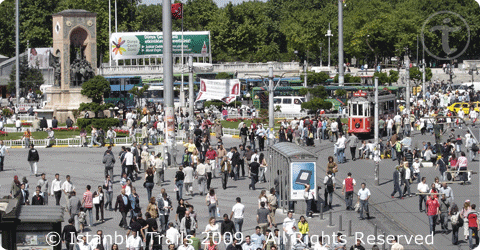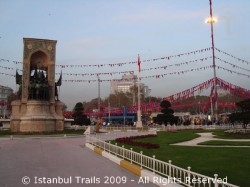Taksim Square (Taksim Meydanı) is considered as the heart of modern Istanbul and symbol of the secular Republic because of the Cumhuriyet Anıtı (Republic Monument) that stands in the middle of the plaza. As a main transportation hub and with numerous hotels, restaurants and pubs surrounding the area, it’s a popular destination for both tourists and locals alike.

History of Taksim Square
Taksim is Arabic for ‘division’ or ‘distribution’. Originally Taksim Square was a water distribution center. In 1732 Sultan Mahmud I ordered the creation of a stone reservoir to collect the water coming from the Belgrade Forest, so it could be distributed to other parts of the city. This stone reservoir can still be seen at the beginning of Istiklal Caddesi.
Taksim Square Today
The Turkish word meydan is translated into English as ‘square’, but actually means ‘large open area’. And that’s really what Taksim Square is: a large open area consisting of two main parts, marked ![]() on the Map with Tourist Attractions in the Modern Part of Istanbul.
on the Map with Tourist Attractions in the Modern Part of Istanbul.
First there is the rectangle shaped area, which serves as a busy hub. No longer for water though, but for public transportation. Not only is it the main transfer point for the municipal bus system, it’s also the starting point of the Istanbul metro with which you can go as far as Atatürk Oto Sanayii or connect to the Kabataş tramway or seaport. And just 100 meters from Taksim Square, you’ll find the Havaş airport shuttle busses and various dolmuş departure points.
 Secondly, there is the triangle shaped area with its garden and the Cumhuriyet Anıtı (Republic Monument) standing in the middle of it. This monument, created by the Italian sculptor Pietro Canonica and unveiled in 1928, features Atatürk, his assistant and successor Ismet İnönü, and other revolutionary leaders. The plaza is also the terminus for the nostalgic tram that runs on Istiklal Caddesi, connecting you to Tünel.
Secondly, there is the triangle shaped area with its garden and the Cumhuriyet Anıtı (Republic Monument) standing in the middle of it. This monument, created by the Italian sculptor Pietro Canonica and unveiled in 1928, features Atatürk, his assistant and successor Ismet İnönü, and other revolutionary leaders. The plaza is also the terminus for the nostalgic tram that runs on Istiklal Caddesi, connecting you to Tünel.
Surrounding Taksim Square and Meeting Points
Taksim Square is surrounded by various landmarks. The prominent building at the far end of the rectangle is the Atatürk Cultural Centre (Atatürk Kültür Merkezi or simply AKM). Another famous landmark is the Marmara Hotel. Next to the square is an elevated green zone called Taksim Park, through which you can reach the Ceylan International Hotel and the Hyatt Regency.
Also noteworthy is McDonalds. It was the very first McDonalds restaurant to open its doors in Turkey, generating long queues at the time with grandfathers, all dressed-up, taking there grandchildren for a bite in the new tasty hamburger that hit the town. While at the subject of junk food, the various snack bars and junk food restaurants at the entrance of Istiklal Caddesi are also considered landmarks in the eyes of the locals. Not for their nouvelle cuisine obviously, but for a quick bite while staggering home after a great night out.
Taksim Square is also a popular meeting point. No need to stress out to be very specific about the exact location or building. Popular meeting points are the Republic Monument, and in front of Burger King or the French Embassy at the beginning of Istiklal Caddesi.
Police Presence, Demonstrations and Public Events
Don’t be intimidated by the round-the-clock police presence on Taksim Square. Being one of the busiest areas in town, people often want to (ab)use its visibility for the benefit of their cause by demonstrating on the square.
However, following many violent demonstrations, with the Taksim Square massacre of May 1st 1977 being the bloodiest and deadliest, all forms of group protests are banned from the square. Therefore, the police are at all times omnipresent on the square. Mostly moderate, but on some occasions you can see riot-police and armored vehicles gearing up to counter-attack any demonstration suspicion. Take my advice and leave the scene as soon as you notice any form of demonstration and skip Taksim Square altogether on May 1st.
That being said, excluded from the demonstration ban are gatherings for public events such as New Year’s eve, Republic Day celebrations or watching important football matches on giant screens set up for the occasion.
Comments on this entry are closed.